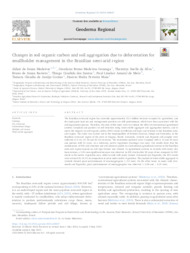Changes in soil organic carbon and soil aggregation due to deforestation for smallholder management in the Brazilian semi-arid region.
Changes in soil organic carbon and soil aggregation due to deforestation for smallholder management in the Brazilian semi-arid region.
Author(s): MEDEIROS, A. de S.; GONZAGA, B. M.; SILVA, T. S. da; BARRETO, B. de S.; SANTOS, T. C. dos; MELO, P. L. A. de; GOMES, T. C. de A.; MAIA, S. M. F.
Summary: The Brazilian semi-arid region has currently approximately 33.3 million hectares occupied by agriculture, and the inadequate land use and management practices are still predominant, which have been associated with the soil degradation process. Therefore, the aims of this study were to evaluate the effect of conventional agricultural systems (cropland and pasture) on soil structure using water-stable aggregate and aggregation indexes, and to assess the impacts on soil organic carbon (SOC) stocks in different soil types and textures in the Brazilian semiarid region. The study was carried out in the municipalities of Delmiro Gouveia, Inhapi and Pariconha, in the Brazilian semi-arid region of the state of Alagoas, Brazil. Arenosols, Acrisols and Regosols soil samples were collected at 0–10, 10–20 and 20–30 cm layers. The treatments analyzed were: Cropland with 4, 15 and 30 years and pasture with 10 years. As a reference, native vegetation (Caatinga) was used. Our results show that the maintenance of SOC and structure and soil physical quality in conventional agricultural systems in the Brazilian semi-arid region depend on soil type/texture and climate. In agricultural systems in Acrisols with sandy clay loam texture, a 5.4% non significant increase was observed in SOC stocks after 30 years of use compared to SOC stocks in the native vegetation area; while in soils with sandy texture (Arenosols and Regosols), the SOC stocks were reduced by 16.1% in comparison to areas under native vegetation. The analysis of water-stable aggregate in Acrisols showed great predominance of macroaggregates (>2.0 mm). On the other hand, in sandy soils (Arenosols and Regosols), great predominance of mesoaggregates was observed (<2.00 and > 0.25 mm).
Publication year: 2023
Types of publication: Journal article
Keywords: Carbono, Desmatamento, Semiárido, Solo
Observation
Some of Embrapa's publications are published as ePub files. To read them, use or download one of the following free software options to your computer or mobile device. Android: Google Play Books; IOS: iBooks; Windows and Linux: Calibre.
Access other publications
Access the Agricultural Research Database (BDPA) to consult Embrapa's full library collection and records.
Visit Embrapa Bookstore to purchase books and other publications sold by Embrapa.

